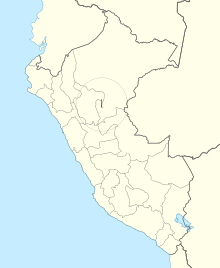Scarlet-banded barbet
| Scarlet-banded barbet | |
|---|---|

| |
| Scientific classification | |
| Domain: | Eukaryota |
| Kingdom: | Animalia |
| Phylum: | Chordata |
| Class: | Aves |
| Order: | Piciformes |
| Family: | Capitonidae |
| Genus: | Capito |
| Species: | C. wallacei
|
| Binomial name | |
| Capito wallacei O'Neill, Lane, Kratter, Capparella & Fox Joo, 2000
| |

| |
| Synonyms | |
|
Scarlet-belted barbet | |
The scarlet-banded barbet (Capito wallacei) is a species of bird in the New World barbet family, Capitonidae. It is endemic to Peru.[2]
Taxonomy and systematics
[edit]The scarlet-belted barbet was discovered in 1996 and formally described in 2000.[3] According to the International Ornithological Committee (IOC), the species is monotypic. However, the South American Classification Committee of the American Ornithological Society (AOS) and the Clements taxonomy include the "Sira barbet" (Capito fitzpatricki) as a subspecies of it.[2][4][5] The Cornell Lab of Ornithology's Birds of the World acknowledges that the "Sira" form is significantly different from the nominate and suggests that it be accorded species rank.[6]
Description
[edit]The scarlet-banded barbet is 19.5 cm (7.7 in) long and weighs 65 to 78 g (2.3 to 2.8 oz). A strikingly colored species, its cap and nape are scarlet, while a broad white supercilium separates the crown from the black ear coverts. Most of the upperparts are black except for a yellow mid-back and large white rump patch. Below, the throat and upper breast are white, bordered below by a broad scarlet band, while the rest of the underparts are shades of yellow.[6]
Distribution and habitat
[edit]The scarlet-banded barbet has been found only on a ridgetop known as Peak 1538 in the remote Cordillera Azul National Park in south-western Loreto, Peru. (It was mistakenly listed as being in Ucayali, Peru, in its formal description.) There it inhabits humid, mossy, sub-montane and montane forest at elevations between 1,350 and 1,500 m (4,430 and 4,920 ft).[3][6]
Behavior
[edit]Feeding
[edit]The scarlet-banded barbet forages in the forest canopy. It was observed in small groups of the same species and in mixed-species foraging flocks. It feeds on fruits and seeds and probably takes insects as well.[3][6]
Breeding
[edit]The scarlet-banded barbet specimens collected during the 1996 expedition indicate that the nesting season is probably March through May. No other information about its breeding habits has been published.[3][6]
Vocalization
[edit]The scarlet-banded barbet's song is " a fast, low-pitched trill...'tdddddd-'" [1] that sounds like a woodpecker's drumming. Its call is a "guttural 'ggrrrakk'" [2].[6]
Status
[edit]The IUCN has assessed the scarlet-banded barbet as Vulnerable. While it appears to be fairly common, its range is tiny and the total population has been estimated at fewer than 1000 individuals.[1]
References
[edit]- ^ a b BirdLife International (2016). "Capito wallacei". IUCN Red List of Threatened Species. 2016: e.T22729471A95016792. doi:10.2305/IUCN.UK.2016-3.RLTS.T22729471A95016792.en. Retrieved 14 September 2023.
- ^ a b Gill, F.; Donsker, D.; Rasmussen, P. (January 2021). "IOC World Bird List (v 11.1)". Retrieved January 14, 2021.
- ^ a b c d O'Neill, John P.; Lane, Daniel F.; Kratter, Andrew W.; Capparella, Angelo P.; Joo, Cecilia Fox (2000). "A striking new species of barbet (Capitoninae: Capito) from the eastern Andes of Peru" (PDF). Auk. 117 (3): 569–577. doi:10.1642/0004-8038(2000)117[0569:ASNSOB]2.0.CO;2.
- ^ Remsen, J. V., Jr., J. I. Areta, E. Bonaccorso, S. Claramunt, A. Jaramillo, D. F. Lane, J. F. Pacheco, M. B. Robbins, F. G. Stiles, and K. J. Zimmer. Version 23 May 2021. A classification of the bird species of South America. American Ornithological Society. https://www.museum.lsu.edu/~Remsen/SACCBaseline.htm retrieved May 24, 2021
- ^ Clements, J. F., T. S. Schulenberg, M. J. Iliff, S. M. Billerman, T. A. Fredericks, B. L. Sullivan, and C. L. Wood. 2019. The eBird/Clements Checklist of Birds of the World: v2019. Downloaded from https://www.birds.cornell.edu/clementschecklist/download/ Retrieved August 15, 2019
- ^ a b c d e f Short, L.L., J. Fjeldså, J. F. M. Horne, C. J. Sharpe, and E. de Juana (2020). Scarlet-banded Barbet (Capito wallacei), version 1.0. In Birds of the World (S. M. Billerman, B. K. Keeney, P. G. Rodewald, and T. S. Schulenberg, Editors). Cornell Lab of Ornithology, Ithaca, NY, USA. https://doi.org/10.2173/bow.scbbar2.01 retrieved May 25, 2021
Additional reading
[edit]- Schulenberg, T.; Stotz, D.; Lane, D.; O'Neill, J.; Parker III, T. (2007). Birds of Peru. Christopher Helm Publishers. ISBN 978-0-7136-8673-9.

